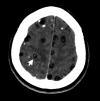Diagnostic criteria for neurocysticercosis, revisited
- PMID: 23265554
- PMCID: PMC4005113
- DOI: 10.1179/2047773212Y.0000000025
Diagnostic criteria for neurocysticercosis, revisited
Abstract
Diagnosis of neurocysticercosis (NCC) can be a challenge. Clinical manifestations are non-specific, most neuroimaging findings are non-pathognomonic, and some serologic tests have low sensitivity or specificity. A set of diagnostic criteria was proposed in 2001 to avoid the over diagnosis of NCC that occurs in epidemiologic surveys, and to help clinicians evaluating patients with suspected NCC. The set included four stratified categories of criteria, including: (1) absolute: histological demonstration of cysticerci, cystic lesions showing the scolex on neuroimaging studies, and direct visualization of subretinal parasites by fundoscopic examination; (2) major: lesions highly suggestive of NCC on neuroimaging studies, positive serum enzyme-linked immunoelectrotransfer blot (EITB) for the detection of anticysticercal antibodies, resolution of intracranial cystic lesions after cysticidal drug therapy, and spontaneous resolution of single enhancing lesions; (3) minor: lesions compatible with NCC on neuroimaging studies, suggestive clinical manifestations, positive cerebrospinal fluid (CSF) ELISA for detection of anticysticercal antibodies or cysticercal antigens, and cysticercosis outside the nervous system; and (4) epidemiological: evidence of a household contact with Taenia solium infection, individuals coming from or living in cysticercosis endemic areas, and history of travel to disease-endemic areas. Interpretation of these criteria permits two degrees of diagnostic certainty: (1) definitive diagnosis, in patients who have one absolute criterion or in those who have two major plus one minor and one epidemiological criteria; and (2) probable diagnosis, in patients who have one major plus two minor criteria, in those who have one major plus one minor and one epidemiological criteria, and in those who have three minor plus one epidemiological criteria. After 10 years of usage, this set has been proved useful in both, field studies, and hospital settings. Recent advances in neuroimaging and immune diagnostic methods have enhanced its accuracy for the diagnosis of NCC.
Figures



Similar articles
-
Proposed diagnostic criteria for neurocysticercosis.Neurology. 2001 Jul 24;57(2):177-83. doi: 10.1212/wnl.57.2.177. Neurology. 2001. PMID: 11480424 Free PMC article. Review.
-
Revised diagnostic criteria for neurocysticercosis.J Neurol Sci. 2017 Jan 15;372:202-210. doi: 10.1016/j.jns.2016.11.045. Epub 2016 Nov 21. J Neurol Sci. 2017. PMID: 28017213 Review.
-
Detection of Taenia solium antigens and anti-T. solium antibodies in paired serum and cerebrospinal fluid samples from patients with intraparenchymal or extraparenchymal neurocysticercosis.J Infect Dis. 2009 May 1;199(9):1345-52. doi: 10.1086/597757. J Infect Dis. 2009. PMID: 19358669 Free PMC article.
-
Added value of antigen ELISA in the diagnosis of neurocysticercosis in resource poor settings.PLoS Negl Trop Dis. 2012;6(10):e1851. doi: 10.1371/journal.pntd.0001851. Epub 2012 Oct 18. PLoS Negl Trop Dis. 2012. PMID: 23094118 Free PMC article.
-
Low sensitivity and frequent cross-reactions in commercially available antibody detection ELISA assays for Taenia solium cysticercosis.Trop Med Int Health. 2018 Jan;23(1):101-105. doi: 10.1111/tmi.13010. Epub 2017 Dec 7. Trop Med Int Health. 2018. PMID: 29160912 Free PMC article.
Cited by
-
Chagas Disease Prevalence in a Cohort of Neurocysticercosis Patients in a Nonendemic Setting.Clin Infect Dis. 2022 Sep 14;75(5):897-900. doi: 10.1093/cid/ciac076. Clin Infect Dis. 2022. PMID: 35134144 Free PMC article.
-
A Large Cohort of Neurocysticercosis in Shandong Province, Eastern China, 1997-2015.Vector Borne Zoonotic Dis. 2019 Dec;19(12):901-907. doi: 10.1089/vbz.2019.2447. Epub 2019 Jul 17. Vector Borne Zoonotic Dis. 2019. PMID: 31314709 Free PMC article.
-
Human taeniasis/cysticercosis: a potentially emerging parasitic disease in Europe.Ann Gastroenterol. 2018 Jul-Aug;31(4):406-412. doi: 10.20524/aog.2018.0260. Epub 2018 Apr 20. Ann Gastroenterol. 2018. PMID: 29991885 Free PMC article. Review.
-
A Case of Sellar/Suprasellar Neurocysticercosis Mimicking a Craniopharyngioma.Asian J Neurosurg. 2021 Feb 23;16(1):204-207. doi: 10.4103/ajns.AJNS_423_20. eCollection 2021 Jan-Mar. Asian J Neurosurg. 2021. PMID: 34211896 Free PMC article.
-
Neurocysticercosis: Diagnostic problems & current therapeutic strategies.Indian J Med Res. 2016 Sep;144(3):319-326. doi: 10.4103/0971-5916.198686. Indian J Med Res. 2016. PMID: 28139530 Free PMC article. Review.
References
-
- Garcia HH, Del Brutto OH. Neurocysticercosis: updated concepts about an old disease. Lancet Neurol. 2005;4:653–61. - PubMed
-
- Del Brutto OH, Santibáñez R, Idrovo L, Rodriguez S, Díaz-Calderon E, Navas C, et al. Epilepsy and neurocysticercosis in Atahualpa: a door-to-door survey in rural coastal Ecuador. Epilepsia. 2005;46:583–7. - PubMed
-
- Medina MT, Durón RM, Martínez L, Osorio JR, Estrada AJ, Zúñiga C, et al. Prevalence, incidence and etiology of epilepsies in rural Honduras: the Salamá study. Epilepsia. 2005;46:124–31. - PubMed
-
- Montano SM, Villaran MV, Ylquimiche L, Figueroa JJ, Rodriguez S, Bautista CT, et al. Neurocysticercosis. Association between seizures, serology, and brain CT in rural Peru. Neurology. 2005;65:229–34. - PubMed
Publication types
MeSH terms
Substances
LinkOut - more resources
Full Text Sources
Medical
